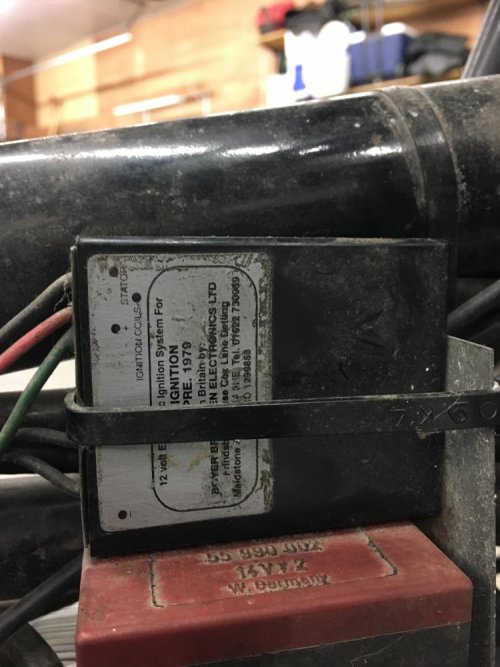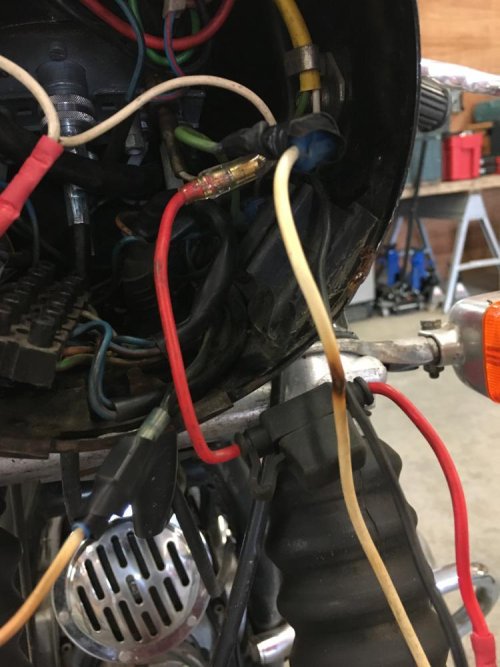bayleyhazen
New member
Intermittent Stumble/Bogging, R75/5 1973
Hi All
I have spent the winter doing some routine maintenance on an LWB R75/5 which I bought last fall, so we're still getting acquainted with each other. Mostly it's running very well - nice and smooth, starts right up when cold, etc. I have done three long test rides of about 100 miles each, in addition to several smaller rides for carb sync purposes.
HOWEVER. I have a problem, which is that on each of my three big test rides there has been an instance of a bogging down which comes out of nowhere, seems to only happen after an hour or so of riding, and then doesn't happen again. It feels like fuel starvation. The bogging lasts anywhere from a few seconds to a minute or two, but it's pretty pronounced, and adding throttle either powers the bike into a rev band where the bogging seems to go away, or increases/induces further bogging. The bogging feels like loss of power for a second or two, then fine, then loss of power, then fine - seemingly random. Sort of a brap, brrrrr, brap, brrrrrrrr. I've tried to induce the bog intentionally, but can't do it - tried going up and down steep hills at various speeds, tried tight, slow maneuvering, tried hard braking and accelerating, going from wide open to closed and back again, and even going down washboard dirt roads, but no dice. After the bogging starts (and goes), the next couple of full stops on the bike result in an idle that is so low the engine lopes and cuts out. Afterwards the bike is totally back to normal.
I'm going grey trying to figure out what it is. I've disassembled and cleaned the carbs completely twice, and replaced all of the O-rings. Diaphragms and needles look fine, as far as I can tell, though one needle has some scuffs like someone used pliers to change the clip position (clip positions and jets are correct according to the Bing book). Shooting starter fluid at the intake hoses while running causes no change in RPM, and compression looks good. Carbs are well synced using the shorting method, though I know I need to adjust the cable free play just off idle. Bike also has new coils, and new plugs. Petcock screens were also cleaned, but petcocks were not totally disassembled. Not much gunk in there, but the gunk was on both sides of the screens. Ignition is controlled by an old Boyer Bransden electronic unit which appears to be working fine and setup properly, confirmed by dynamic testing with a timing light.
So, any ideas? My best theory at this stage is still intermittent fuel loss, so I'm going to double-check the floats and fit some bigger sintered in-line fuel filters. My other theory is an intermittent electrical short, but I've checked and cleaned every connection I can easily get to, and nothing looks pinched or frayed. I'm hoping to not have to get into the headlight pod and check everything there, but that's probably next. I'm really just guessing at this point. Could it be sticking carb slides?
Thanks, appreciate the help. I love finding and fixing problems on these bikes, but I'm stumped!
Other issues I'm having but may be unrelated - carb on the right side has a particularly unresponsive idle mix screw. It responds slower and has a comparatively wide band of no-effect adjustment. Other issue is an occasional starter solenoid clicking and not cranking, but fully charged battery seems to solve that. Also, one time I turned the ignition on and the GEN bulb didn't light up. Next time it did, and that symptom has never repeated since. I also spliced a pigtail into the wiring harness so that the parking light would work, but that has since stopped working - another sign I need to get back into the pod, but not sure if anything in there could even cause this bogging.
Thanks again.
Hi All
I have spent the winter doing some routine maintenance on an LWB R75/5 which I bought last fall, so we're still getting acquainted with each other. Mostly it's running very well - nice and smooth, starts right up when cold, etc. I have done three long test rides of about 100 miles each, in addition to several smaller rides for carb sync purposes.
HOWEVER. I have a problem, which is that on each of my three big test rides there has been an instance of a bogging down which comes out of nowhere, seems to only happen after an hour or so of riding, and then doesn't happen again. It feels like fuel starvation. The bogging lasts anywhere from a few seconds to a minute or two, but it's pretty pronounced, and adding throttle either powers the bike into a rev band where the bogging seems to go away, or increases/induces further bogging. The bogging feels like loss of power for a second or two, then fine, then loss of power, then fine - seemingly random. Sort of a brap, brrrrr, brap, brrrrrrrr. I've tried to induce the bog intentionally, but can't do it - tried going up and down steep hills at various speeds, tried tight, slow maneuvering, tried hard braking and accelerating, going from wide open to closed and back again, and even going down washboard dirt roads, but no dice. After the bogging starts (and goes), the next couple of full stops on the bike result in an idle that is so low the engine lopes and cuts out. Afterwards the bike is totally back to normal.
I'm going grey trying to figure out what it is. I've disassembled and cleaned the carbs completely twice, and replaced all of the O-rings. Diaphragms and needles look fine, as far as I can tell, though one needle has some scuffs like someone used pliers to change the clip position (clip positions and jets are correct according to the Bing book). Shooting starter fluid at the intake hoses while running causes no change in RPM, and compression looks good. Carbs are well synced using the shorting method, though I know I need to adjust the cable free play just off idle. Bike also has new coils, and new plugs. Petcock screens were also cleaned, but petcocks were not totally disassembled. Not much gunk in there, but the gunk was on both sides of the screens. Ignition is controlled by an old Boyer Bransden electronic unit which appears to be working fine and setup properly, confirmed by dynamic testing with a timing light.
So, any ideas? My best theory at this stage is still intermittent fuel loss, so I'm going to double-check the floats and fit some bigger sintered in-line fuel filters. My other theory is an intermittent electrical short, but I've checked and cleaned every connection I can easily get to, and nothing looks pinched or frayed. I'm hoping to not have to get into the headlight pod and check everything there, but that's probably next. I'm really just guessing at this point. Could it be sticking carb slides?
Thanks, appreciate the help. I love finding and fixing problems on these bikes, but I'm stumped!
Other issues I'm having but may be unrelated - carb on the right side has a particularly unresponsive idle mix screw. It responds slower and has a comparatively wide band of no-effect adjustment. Other issue is an occasional starter solenoid clicking and not cranking, but fully charged battery seems to solve that. Also, one time I turned the ignition on and the GEN bulb didn't light up. Next time it did, and that symptom has never repeated since. I also spliced a pigtail into the wiring harness so that the parking light would work, but that has since stopped working - another sign I need to get back into the pod, but not sure if anything in there could even cause this bogging.
Thanks again.
Last edited:







